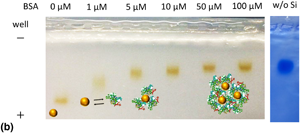Article contents
Stable near-infrared photoluminescence from silicon quantum dot–bovine serum albumin composites
Published online by Cambridge University Press: 11 November 2020
Abstract

The interaction between negatively charged all-inorganic silicon quantum dots (Si QDs) and bovine serum albumin (BSA) is studied. It is shown that a small difference in the size of Si QDs affects the structure of Si QD–BSA composites significantly. When the diameter of Si QDs is 4 nm, a heterodimer (~20 nm) composed of one Si QD and one BSA molecule is a preferable and stable structure. On the other hand, when the diameter is 7 nm, the size of the composites increases to ~50 nm. The Si QD–BSA composites exhibit stable photoluminescence in the near-infrared range in phosphate-buffered saline.
- Type
- Research Letters
- Information
- Copyright
- Copyright © The Author(s), 2020, published on behalf of Materials Research Society by Cambridge University Press
References
- 3
- Cited by





